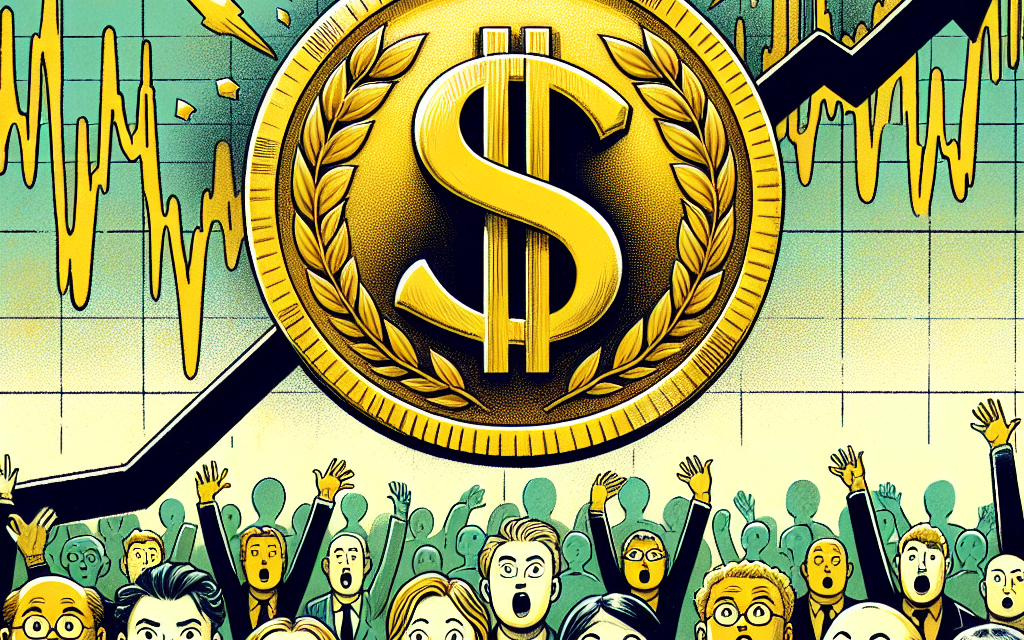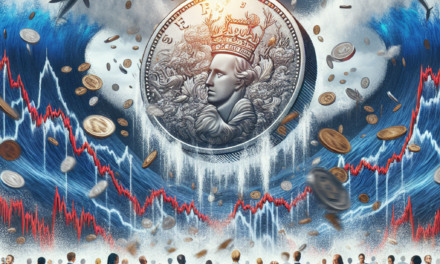“Decoding the Climb: Unveiling the Forces Behind Rising Interest Rates”
Introduction
The recent surge in interest rates has captured the attention of economists, investors, and policymakers alike, as it signals significant shifts in the global financial landscape. This phenomenon, characterized by a rapid increase in borrowing costs, has far-reaching implications for economic growth, consumer spending, and investment strategies. Understanding the driving forces behind this spike is crucial for stakeholders across various sectors. Factors such as inflationary pressures, central bank policies, geopolitical tensions, and shifts in market sentiment all play pivotal roles in shaping the current interest rate environment. By unraveling these complex dynamics, we can gain insights into the potential trajectory of interest rates and their broader economic impact.
Economic Recovery and Inflation Pressures
The recent surge in interest rates has become a focal point of economic discussions, as it reflects broader dynamics within the global economy. Understanding the factors driving this spike requires a comprehensive examination of the interplay between economic recovery and inflation pressures. As economies worldwide emerge from the shadows of the pandemic, the path to recovery has been marked by a complex set of challenges and opportunities, each contributing to the current interest rate environment.
To begin with, the economic recovery has been more robust than initially anticipated, fueled by a combination of government stimulus measures, pent-up consumer demand, and the gradual reopening of businesses. This resurgence in economic activity has led to increased spending, which, while beneficial for growth, has also exerted upward pressure on prices. As demand outpaces supply in certain sectors, inflationary pressures have mounted, prompting central banks to reassess their monetary policies. In this context, the rise in interest rates can be seen as a response to the need to curb inflation and maintain economic stability.
Moreover, the supply chain disruptions experienced during the pandemic have further exacerbated inflationary trends. With global supply chains still struggling to return to pre-pandemic efficiency, shortages of key materials and components have led to price increases across various industries. These supply-side constraints have contributed to the inflationary environment, compelling central banks to consider interest rate hikes as a tool to temper demand and prevent the economy from overheating.
In addition to these factors, labor market dynamics have played a significant role in shaping the current interest rate landscape. The pandemic-induced shifts in employment patterns have led to labor shortages in certain sectors, driving up wages as businesses compete for a limited pool of workers. This increase in labor costs has, in turn, been passed on to consumers in the form of higher prices, further fueling inflation. As central banks aim to balance the dual objectives of fostering employment and controlling inflation, interest rate adjustments have become a critical component of their strategy.
Furthermore, the global nature of the economic recovery has introduced additional complexities. Divergent recovery trajectories among countries have led to varying inflationary pressures and monetary policy responses. In some regions, where recovery has been swift and inflation more pronounced, central banks have moved more aggressively to raise interest rates. Conversely, in areas where recovery remains sluggish, monetary authorities have been more cautious, opting to maintain accommodative policies to support growth. This divergence has implications for global capital flows and exchange rates, adding another layer of complexity to the interest rate equation.
As we consider the broader implications of rising interest rates, it is essential to recognize the potential impact on various sectors of the economy. Higher borrowing costs can dampen investment and consumer spending, potentially slowing down the pace of recovery. However, if managed carefully, interest rate increases can help prevent the economy from overheating and ensure sustainable growth in the long term. Policymakers face the delicate task of calibrating their actions to strike the right balance between supporting recovery and containing inflation.
In conclusion, the recent surge in interest rates is a multifaceted phenomenon driven by the interplay of economic recovery and inflation pressures. As central banks navigate this complex landscape, their decisions will have far-reaching implications for the global economy. Understanding the underlying factors and potential consequences of these interest rate movements is crucial for stakeholders across the economic spectrum, as they adapt to an evolving financial environment.
Central Bank Policies and Interest Rate Adjustments
In recent months, the global financial landscape has been marked by a notable surge in interest rates, a development that has captured the attention of economists, policymakers, and investors alike. This upward trend in interest rates can be attributed to a confluence of factors, with central bank policies playing a pivotal role in shaping the current economic environment. As we delve into the intricacies of this phenomenon, it becomes evident that understanding the motivations and implications of central bank actions is crucial for comprehending the broader economic implications.
To begin with, central banks around the world have been grappling with the challenge of balancing economic growth with inflationary pressures. In the wake of the COVID-19 pandemic, many economies experienced unprecedented fiscal and monetary stimulus measures aimed at mitigating the economic fallout. While these measures were instrumental in averting a deeper recession, they also laid the groundwork for inflationary pressures as economies began to recover. Consequently, central banks have been compelled to reassess their monetary policies to address rising inflation, which has been a significant driver of the recent interest rate hikes.
Moreover, the decision to adjust interest rates is often influenced by the central banks’ dual mandate of promoting maximum employment and ensuring price stability. As inflation rates have surged beyond the target levels set by many central banks, there has been a growing consensus that tightening monetary policy is necessary to rein in inflation. This has led to a series of interest rate hikes, as central banks aim to temper demand and prevent the economy from overheating. By increasing interest rates, central banks seek to make borrowing more expensive, thereby curbing consumer spending and business investment, which in turn can help moderate inflationary pressures.
In addition to domestic considerations, global economic dynamics have also played a role in shaping central bank policies. The interconnectedness of the global economy means that developments in one region can have ripple effects across the world. For instance, the monetary policy decisions of major central banks, such as the Federal Reserve in the United States or the European Central Bank, often influence the policy choices of other central banks. As these major institutions embark on a path of monetary tightening, other central banks may follow suit to prevent capital outflows and maintain currency stability.
Furthermore, the recent surge in interest rates can also be attributed to the evolving expectations of market participants. Financial markets are inherently forward-looking, and investors often adjust their portfolios based on anticipated changes in monetary policy. As central banks signal their intentions to raise interest rates, market participants may preemptively adjust their investment strategies, leading to fluctuations in bond yields and other interest rate-sensitive assets. This dynamic interplay between central bank communications and market expectations underscores the importance of clear and transparent communication from policymakers to minimize market volatility.
In conclusion, the recent spike in interest rates is a multifaceted phenomenon driven by a combination of central bank policies, inflationary pressures, and global economic dynamics. As central banks navigate the delicate task of normalizing monetary policy, their actions will continue to have far-reaching implications for the global economy. Understanding the motivations behind these policy adjustments is essential for stakeholders seeking to navigate the evolving financial landscape. As we move forward, the interplay between central bank decisions and market reactions will remain a critical area of focus for economists and investors alike.
Global Supply Chain Disruptions
The recent surge in interest rates has captured the attention of economists, policymakers, and the general public alike, prompting a closer examination of the underlying factors driving this phenomenon. Among the myriad influences, global supply chain disruptions have emerged as a significant contributor, intertwining with other economic forces to create a complex landscape. To understand the role of supply chain disruptions in the current interest rate environment, it is essential to explore how these disruptions have evolved and their broader economic implications.
In recent years, global supply chains have faced unprecedented challenges, stemming from a combination of geopolitical tensions, natural disasters, and the lingering effects of the COVID-19 pandemic. These disruptions have led to significant bottlenecks in the production and distribution of goods, resulting in increased costs and delays. As supply chains struggle to meet demand, the prices of goods and services have risen, contributing to inflationary pressures worldwide. Central banks, tasked with maintaining price stability, have responded by raising interest rates in an effort to curb inflation and prevent economies from overheating.
Moreover, the interconnected nature of global supply chains means that disruptions in one region can have far-reaching effects. For instance, a shortage of semiconductors in Asia can lead to production slowdowns in the automotive industry in Europe and North America. This ripple effect exacerbates the supply-demand imbalance, further fueling inflation. As inflation expectations rise, central banks are compelled to act preemptively, adjusting interest rates to signal their commitment to controlling inflation and maintaining economic stability.
In addition to inflationary pressures, supply chain disruptions have also impacted economic growth, another key consideration for central banks when setting interest rates. Delays and shortages have hindered production capabilities, leading to slower economic recovery in many regions. This slowdown has prompted central banks to carefully balance their interest rate policies, aiming to support growth while simultaneously addressing inflation concerns. The delicate nature of this balancing act underscores the complexity of the current economic environment and the challenges faced by policymakers.
Furthermore, the labor market has not been immune to the effects of supply chain disruptions. As companies grapple with production challenges, many have been forced to adjust their workforce needs, leading to shifts in employment patterns. In some cases, this has resulted in labor shortages, particularly in industries heavily reliant on global supply chains. These labor market dynamics add another layer of complexity to the interest rate equation, as central banks must consider the potential impact of rate changes on employment levels.
In conclusion, the recent surge in interest rates can be attributed, in part, to the pervasive disruptions in global supply chains. These disruptions have contributed to inflationary pressures, impacted economic growth, and influenced labor market dynamics, all of which are critical factors in central banks’ decision-making processes. As the world continues to navigate these challenges, the interplay between supply chain disruptions and interest rates will remain a focal point for economists and policymakers. Understanding this relationship is crucial for anticipating future economic trends and crafting effective monetary policies that promote stability and growth in an increasingly interconnected global economy.
Government Fiscal Stimulus Impact

The recent surge in interest rates has captured the attention of economists, policymakers, and the general public alike, prompting a closer examination of the underlying factors driving this phenomenon. Among the myriad influences, government fiscal stimulus emerges as a significant contributor, playing a pivotal role in shaping the current economic landscape. To understand the impact of fiscal stimulus on interest rates, it is essential to explore the mechanisms through which government spending influences economic activity and, consequently, borrowing costs.
Fiscal stimulus typically involves increased government spending or tax cuts aimed at boosting economic growth, particularly during periods of economic downturn. In response to recent global economic challenges, many governments have implemented substantial fiscal measures to support their economies. These measures, while providing immediate relief and fostering recovery, have also led to increased demand for goods and services. As a result, the economy experiences upward pressure on prices, contributing to inflationary trends.
Inflation, in turn, plays a crucial role in the dynamics of interest rates. Central banks, tasked with maintaining price stability, often respond to rising inflation by adjusting monetary policy. One common approach is to increase interest rates to curb inflationary pressures. By making borrowing more expensive, higher interest rates can temper consumer spending and business investment, thereby cooling down an overheating economy. Consequently, the interplay between fiscal stimulus and inflation becomes a key driver of interest rate movements.
Moreover, the scale and timing of fiscal stimulus can further amplify its impact on interest rates. Large-scale government spending programs, particularly those financed through borrowing, can lead to increased demand for credit in financial markets. This heightened demand can push up interest rates as lenders seek higher returns to compensate for the increased risk associated with lending in an environment of rising inflation. Additionally, the timing of fiscal interventions can influence market expectations, with anticipations of future inflation prompting preemptive adjustments in interest rates.
Another dimension to consider is the role of government debt in shaping interest rate trends. As governments finance fiscal stimulus through borrowing, the resulting increase in public debt levels can affect investor perceptions and market dynamics. Higher debt levels may lead to concerns about fiscal sustainability, prompting investors to demand higher yields on government bonds to offset perceived risks. This, in turn, can contribute to upward pressure on interest rates across the broader economy.
Furthermore, the global nature of fiscal stimulus efforts adds complexity to the interest rate landscape. Coordinated fiscal measures across multiple countries can lead to synchronized economic recoveries, amplifying inflationary pressures on a global scale. This interconnectedness means that interest rate movements in one country can have ripple effects across international financial markets, influencing borrowing costs worldwide.
In conclusion, the recent surge in interest rates can be attributed, in part, to the impact of government fiscal stimulus. By stimulating economic activity and contributing to inflationary pressures, fiscal measures have prompted central banks to adjust monetary policy, leading to higher interest rates. The scale, timing, and global coordination of these efforts further shape the interest rate environment, highlighting the intricate relationship between fiscal policy and borrowing costs. As governments continue to navigate the complexities of economic recovery, understanding the interplay between fiscal stimulus and interest rates remains crucial for informed decision-making and effective policy formulation.
Labor Market Dynamics and Wage Growth
The recent surge in interest rates has captured the attention of economists, policymakers, and the general public alike, prompting a closer examination of the underlying factors driving this phenomenon. Among the myriad influences, labor market dynamics and wage growth stand out as pivotal elements in understanding the current economic landscape. As the global economy continues to recover from the disruptions caused by the COVID-19 pandemic, labor markets have experienced significant shifts, which in turn have impacted wage growth and, consequently, interest rates.
To begin with, the labor market has undergone substantial changes in the wake of the pandemic, with many industries facing labor shortages and increased demand for skilled workers. This imbalance between supply and demand has led to upward pressure on wages as employers compete to attract and retain talent. In particular, sectors such as technology, healthcare, and logistics have seen notable wage increases, reflecting the heightened demand for workers in these fields. As wages rise, so too does consumer spending power, which can lead to increased demand for goods and services, thereby fueling inflationary pressures.
Inflation, a key determinant of interest rates, has been a focal point for central banks worldwide. As inflation rates climb, central banks often respond by raising interest rates to curb excessive spending and stabilize the economy. The relationship between wage growth and inflation is complex, as higher wages can contribute to inflation by increasing production costs for businesses, which may then pass these costs onto consumers in the form of higher prices. Consequently, the recent wage growth observed in various sectors has played a significant role in the upward trajectory of interest rates.
Moreover, the labor market’s recovery has been uneven across different regions and demographics, further complicating the picture. While some areas have seen robust job growth and wage increases, others continue to struggle with high unemployment rates and stagnant wages. This disparity can influence national economic policies and interest rate decisions, as policymakers strive to balance the needs of diverse labor markets. Additionally, the ongoing shift towards remote work and digitalization has altered traditional labor market dynamics, creating new opportunities and challenges that impact wage growth and economic stability.
Another factor contributing to the surge in interest rates is the global supply chain disruptions that have persisted since the onset of the pandemic. These disruptions have led to shortages of key materials and goods, driving up prices and contributing to inflationary pressures. As businesses face higher input costs, they may be compelled to raise wages to maintain productivity and employee satisfaction, further fueling the cycle of wage growth and inflation.
In light of these developments, central banks are tasked with the delicate balancing act of managing interest rates to support economic growth while keeping inflation in check. The interplay between labor market dynamics, wage growth, and interest rates underscores the complexity of the current economic environment. As policymakers navigate these challenges, they must consider the broader implications of their decisions on both domestic and global scales.
In conclusion, the recent surge in interest rates can be attributed, in part, to the evolving dynamics of the labor market and the resultant wage growth. As economies continue to adapt to post-pandemic realities, understanding the intricate connections between these factors is crucial for formulating effective monetary policies. By closely monitoring labor market trends and wage developments, policymakers can better anticipate future shifts in interest rates and implement strategies to foster sustainable economic growth.
Geopolitical Tensions and Market Uncertainty
The recent surge in interest rates has captured the attention of economists, investors, and policymakers alike, as they seek to understand the underlying factors driving this significant shift. One of the primary contributors to this phenomenon is the prevailing geopolitical tensions that have created an atmosphere of uncertainty in global markets. As nations grapple with complex diplomatic challenges, the resulting instability has led to a cautious approach among investors, who are increasingly seeking safe havens for their capital. This shift in investment behavior has, in turn, exerted upward pressure on interest rates, as demand for secure assets such as government bonds rises.
In addition to geopolitical tensions, market uncertainty has played a crucial role in the recent interest rate spike. The global economy is currently navigating a myriad of challenges, including supply chain disruptions, fluctuating commodity prices, and the lingering effects of the COVID-19 pandemic. These factors have collectively contributed to an unpredictable economic landscape, prompting central banks to reassess their monetary policies. In response to rising inflationary pressures, many central banks have opted to increase interest rates as a means of curbing inflation and stabilizing their economies. This policy shift has further fueled the upward trajectory of interest rates, as financial markets adjust to the new monetary environment.
Moreover, the interplay between geopolitical tensions and market uncertainty has been exacerbated by the interconnectedness of the global economy. In an era where economic activities transcend national borders, the ripple effects of regional conflicts and economic disruptions are felt worldwide. For instance, tensions in Eastern Europe or trade disputes in Asia can have far-reaching implications for global supply chains, commodity markets, and investor sentiment. As these events unfold, they contribute to a climate of uncertainty that influences interest rate dynamics across the globe.
Furthermore, the role of investor psychology cannot be overlooked when examining the recent surge in interest rates. In times of uncertainty, investors tend to exhibit risk-averse behavior, gravitating towards assets perceived as low-risk. This flight to safety often results in increased demand for government securities, which are traditionally viewed as stable investments. As demand for these securities rises, their yields—and consequently, interest rates—tend to increase. This phenomenon underscores the intricate relationship between investor sentiment and interest rate movements, highlighting the importance of psychological factors in shaping financial markets.
In light of these considerations, it becomes evident that the recent spike in interest rates is not attributable to a single cause but rather a confluence of factors. Geopolitical tensions, market uncertainty, and investor psychology have all played pivotal roles in shaping the current interest rate landscape. As policymakers and market participants navigate this complex environment, it is crucial to adopt a holistic approach that takes into account the multifaceted nature of these influences.
Looking ahead, the trajectory of interest rates will likely continue to be influenced by the evolving geopolitical and economic landscape. As nations work towards resolving diplomatic conflicts and stabilizing their economies, the degree of uncertainty in global markets may diminish, potentially leading to a moderation in interest rate movements. However, given the inherent unpredictability of geopolitical events and economic developments, it remains essential for stakeholders to remain vigilant and adaptable in their strategies. By understanding the intricate interplay of factors driving interest rate changes, they can better position themselves to navigate the challenges and opportunities that lie ahead.
Investor Sentiment and Market Speculation
The recent surge in interest rates has captured the attention of investors and market analysts alike, prompting a closer examination of the underlying factors driving this upward trend. As interest rates rise, they inevitably influence investor sentiment and market speculation, creating a ripple effect across various sectors of the economy. To understand the dynamics at play, it is essential to consider the interplay between economic indicators, central bank policies, and investor behavior.
One of the primary drivers of the recent increase in interest rates is the shift in monetary policy by central banks. In response to persistent inflationary pressures, many central banks have adopted a more hawkish stance, signaling a departure from the ultra-accommodative policies that characterized the pandemic era. This shift is largely motivated by the need to rein in inflation, which has been exacerbated by supply chain disruptions and increased consumer demand. As central banks raise benchmark interest rates, borrowing costs for businesses and consumers rise, leading to a broader increase in interest rates across the board.
In addition to central bank policies, economic indicators have played a significant role in shaping investor sentiment. Strong employment figures, robust consumer spending, and resilient economic growth have contributed to the perception that the economy is on solid footing. This optimism, however, is tempered by concerns over inflation, which remains a key risk factor. As investors weigh these competing narratives, their expectations for future interest rate movements are reflected in bond yields and other financial instruments.
Market speculation further amplifies the impact of these factors on interest rates. Investors, anticipating future rate hikes, may adjust their portfolios accordingly, leading to increased demand for certain assets and a corresponding rise in yields. This speculative behavior can create a self-reinforcing cycle, where expectations of higher rates drive actual increases in interest rates. Moreover, the interconnectedness of global financial markets means that developments in one region can have far-reaching implications, influencing investor sentiment and market dynamics worldwide.
The role of investor sentiment cannot be overstated in this context. As interest rates rise, the cost of capital increases, potentially dampening investment and consumer spending. This, in turn, can lead to shifts in market sentiment, as investors reassess the risk-reward profile of various asset classes. Equities, for instance, may become less attractive relative to fixed-income securities, prompting a reallocation of capital. Such shifts can have significant implications for market volatility and asset valuations.
Furthermore, the current economic environment is characterized by heightened uncertainty, with geopolitical tensions, energy price fluctuations, and ongoing pandemic-related challenges adding layers of complexity to the investment landscape. In this context, investor sentiment is particularly sensitive to new information, with market participants closely monitoring central bank communications, economic data releases, and geopolitical developments for clues about the future trajectory of interest rates.
In conclusion, the recent surge in interest rates is the result of a confluence of factors, including central bank policies, economic indicators, and market speculation. As investors navigate this complex environment, their sentiment and expectations play a crucial role in shaping market dynamics. Understanding these interconnections is essential for making informed investment decisions and anticipating future trends in interest rates. As the global economy continues to evolve, staying attuned to these developments will be key for investors seeking to manage risk and capitalize on opportunities in an ever-changing financial landscape.
Q&A
1. **What are the primary factors driving the recent surge in interest rates?**
– The primary factors include inflationary pressures, central bank monetary policy adjustments, increased government borrowing, and global economic recovery dynamics.
2. **How does inflation impact interest rates?**
– Higher inflation often leads central banks to raise interest rates to curb spending and stabilize prices, as higher rates can reduce borrowing and spending.
3. **What role do central banks play in influencing interest rates?**
– Central banks influence interest rates through monetary policy tools such as setting benchmark rates and conducting open market operations to control money supply and demand.
4. **How does government borrowing affect interest rates?**
– Increased government borrowing can lead to higher interest rates as the government competes with the private sector for available funds, potentially driving up the cost of borrowing.
5. **What is the impact of global economic recovery on interest rates?**
– As economies recover, demand for credit increases, potentially leading to higher interest rates as lenders adjust to increased demand and potential inflationary pressures.
6. **How do geopolitical events influence interest rates?**
– Geopolitical events can create uncertainty, affecting investor confidence and risk perceptions, which can lead to fluctuations in interest rates as markets adjust to new information.
7. **What are the potential long-term effects of sustained high interest rates?**
– Sustained high interest rates can slow economic growth by increasing borrowing costs, reducing consumer spending and business investment, and potentially leading to higher unemployment.
Conclusion
The recent surge in interest rates can be attributed to a combination of factors, including rising inflationary pressures, central banks’ monetary policy adjustments, and increased government borrowing. Inflation has been driven by supply chain disruptions, labor market shifts, and heightened consumer demand post-pandemic. In response, central banks have signaled tighter monetary policies, including rate hikes, to curb inflation. Additionally, increased government spending and borrowing to support economic recovery have contributed to upward pressure on interest rates. These elements together create a complex environment where interest rates are rising as a reflection of both economic recovery and the challenges of managing inflation and fiscal policy.





